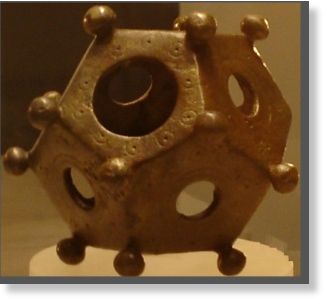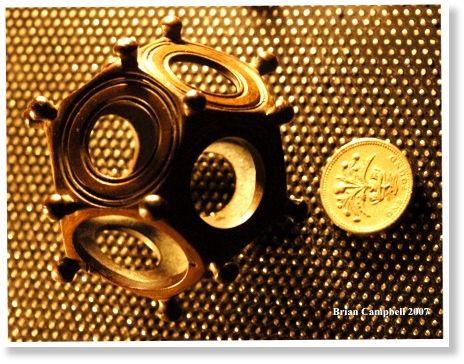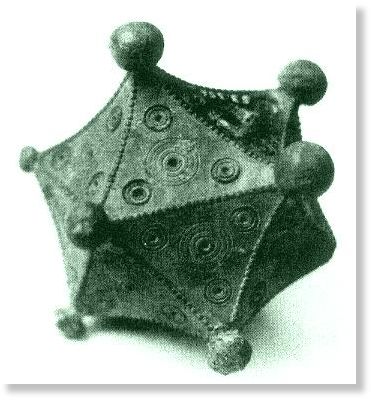About 100 of these curious objects have been found, from England in the north and Hungary in the east to Italy, with the greatest number discovered in the west of Germany and in France. They appear in various contexts, and have been constructed of several materials, such as bronze and stone.
No-one knows what they were used for. They are never mentioned in contemporary literature and do not appear in any surviving pictures of the time. Various conjectures exist as to their use, from being used to calibrate the size of water pipes, through candle holders (wax was found in one of them) to army parade standard bases, however, the most widely-held theory is that they were religious artifacts of some sort, possibly used in rites derived from Celtic sources.
Roman Dodecahedra Found in English GardenIn an article in the Mathematical Intelligencer, Vol. 18, pp. 132-133, 1996 entitled, "A Roman Icosahedron Discovered", Benno Artmann describes the a 'Roman' icosahedron. It is also hollow, bronze, and about 8 cm in diameter. This only deepens the mystery as to the function of these objects.
by Brian Campbell
"Some 20 years ago while digging in my rear garden north of Romford, England I came across a Roman Dodecahedra. At the time I had no idea what I had found until some years later.
I saw one displayed in a Roman Fort Museum outside Frankfurt, Germany.
I subsequently took the item to the British Museum, where I was told it was either a fake or one of the best examples of a Roman Dodecahedra found to date. I, of course, know it to be genuine in as much as I discovered it when removing a tree stump and buried perhaps two feet down.
I have to say I was very disappointed by the response I had from British Museum staff, although to be fair they were working in temporary accommodation during renovations to the Museum when I visited them.
I have always wondered about the little 'mushroom' pegs or legs, as they appear to me to be important, not just left over from casting the metal. My theory before I knew the artefact to be Roman was that it was a plumber's form for checking the diameter of pipes.
Each hole/bore is a different diameter, ten are beautifully formed, each with three concentric circles furrowed around them, while the remaining two, which might be described as top and bottom, are more roughly formed, with no concentric circles.
The bottom/base one in my orientation being the largest diameter bore, the top one being slightly smaller in diameter, but both larger in diameter than any of the ten others. I believe for this reason some have speculated the dodecahedra might have been impailed upon a stake, pike or staff.
Returning to the pegs, which appear to have been purposely shaped into 'mushrooms', I can see in my minds eye it covered in a leather jacket, the pegs being pressed through eyelets to hold the covering in place..
Artmann also reports one Roman icosahedron, illustrated at left. It is also hollow, bronze, and about 8 cm in diameter. This only deepens the mystery as to the function of these objects.
Interestingly, it was put away in a museum's basement storage, misclassified as a "dodecahedron" for forty years before someone noticed it was not a dodecahedron. That illustrates nicely how people see things differently depending on their background knowledge.
Maybe fanciful on my part as the dodecahedra is truly a lovely piece of art-form, fuctional or not. .. My Dodecahedra is made of bronze I believe and of a brown coppery colour, it truly is magical and fascinating!
I have read that these Dodecahedra may be Druidic in origin and seized by the Romans during their occupations. I find this difficult to believe. For if their value to the Druids was as important as has been speculated, I would have expected the Druids to have secreted them away and at least some to have been found in places other than those occupied by the Roman Legions.
That said, there remains the question why Dedecahedra have not to my knowledge been discovered in Italy, even if only taken there as spoils of war.
Interestingly, the icosahedron was put away in a museum's basement storage, misclassified as a "dodecahedron" for forty years before someone noticed it was not a dodecahedron.






They're weapons.